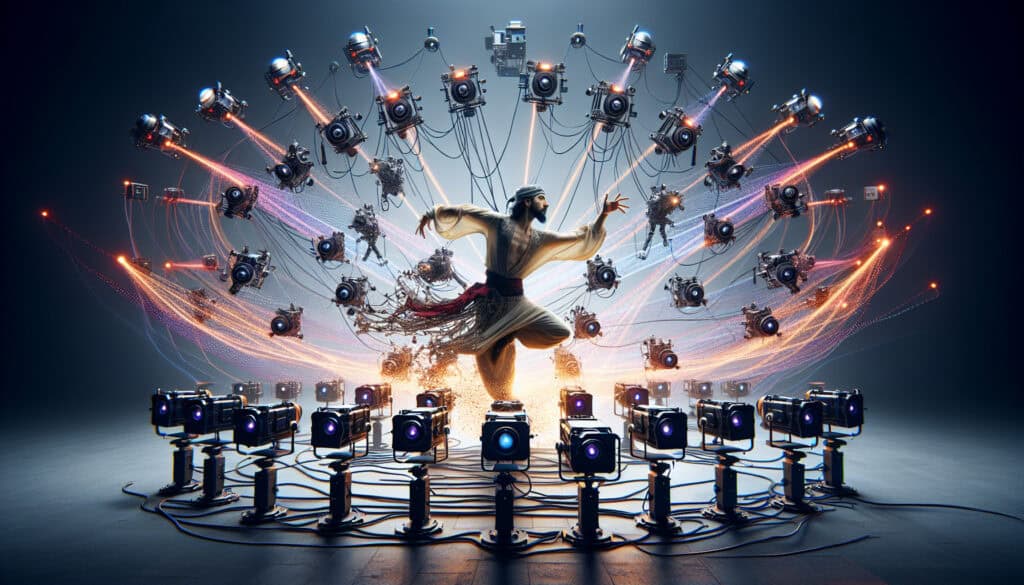To record the movement of objects or people.
- Methodologies: Customers & Marketing, Ideation, Product Design
Motion Capture Systems

Motion Capture Systems
- Design for Additive Manufacturing (DfAM), Digital Twin, Ergonomics, Human Factors, Human-Centered Design, Prototyping, Robotics, Simulation
Objective:
How it’s used:
- A technology for recording human movement and translating it into a digital format. It is used in a variety of applications, from entertainment and sports to medicine and engineering.
Pros
- Provides detailed and accurate data on human movement; Can be used to create realistic animations and simulations.
Cons
- Can be expensive and complex to set up and use; The markers can be intrusive and may affect the person's movement.
Categories:
- Engineering, Ergonomics, Product Design
Best for:
- Analyzing the movement of an athlete to improve their performance, or the movement of a worker to design a more ergonomic workstation.
Motion capture systems serve numerous industries including film, video games, virtual reality, biomechanics, rehabilitation, and human-computer interaction. In the entertainment sector, the technology facilitates the creation of lifelike animations and characters in movies and video games, enabling filmmakers and game developers to translate real human movements into digital formats. In sports science, motion capture is used to analyze athletes’ performance by capturing their biomechanics, which helps coaches and trainers refine techniques and reduce injury risks. Healthcare professionals employ motion capture to evaluate patients’ movement patterns for rehabilitation purposes, analyzing how they can optimize their recovery through tailored physical therapy programs. Engineers leverage this technology when designing ergonomic products, ensuring that tools, workstations, and even vehicles enhance user comfort while minimizing strain and injury. The process typically involves collaboration among animators, biomechanical analysts, therapists, and product designers who gather data through cameras and sensors placed on subjects, translating it into actionable insights that drive innovation across these fields. Its ability to provide precise data enables continuous improvement through iterative design, making it a valuable methodology for teams that seek to enhance user experiences or performance outcomes.
Key steps of this methodology
- Select appropriate motion capture technology based on application requirements. <li.Configure the motion capture environment, ensuring optimal lighting and space conditions. <li.Set up markers on subject or body segments according to specific tracking needs. <li.Perform system calibration to ensure accurate 3D spatial capture of movements. <li.Execute test captures to verify system accuracy and marker visibility. <li.Record motion sequences during various activities, ensuring capture of relevant movements. <li.Process raw data using motion capture software to translate movements into digital models. <liAnalyze processed data to assess movement patterns and identify areas for improvement. <liIntegrate motion data into simulation or design tools for further analysis or ergonomic assessments. <liIterate on design or performance recommendations based on analysis outcomes.
Pro Tips
- Incorporate advanced filtering and machine learning algorithms in your data processing pipeline to enhance the accuracy of motion analysis and identify subtle movement patterns.
- Utilize a hybrid motion capture approach, combining optical and inertial systems, for improved data robustness and versatility in various environments.
- Engage in interdisciplinary collaboration with biomechanics experts to interpret the data in ways that provide actionable recommendations for performance enhancement or ergonomic design.
To read and compare several methodologies, we recommend the
> Extensive Methodologies Repository <
together with the 400+ other methodologies.
Your comments on this methodology or additional info are welcome on the comment section below ↓ , so as any engineering-related ideas or links.
Historical Context
1986
(if date is unknown or not relevant, e.g. "fluid mechanics", a rounded estimation of its notable emergence is provided)

Related Posts
Manufacturing Execution System (MES)
Manufacturing Control Plan
Manual Testing
Manual Handling Assessment Charts (MAC)
ManTRA (Manual Tasks Risk Assessment Tool)
Make-to-Stock (MTS)